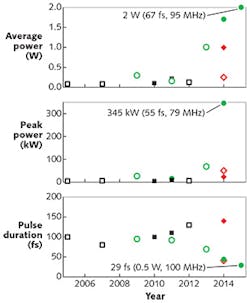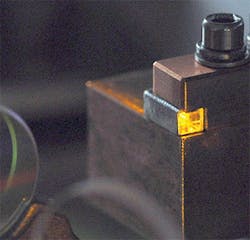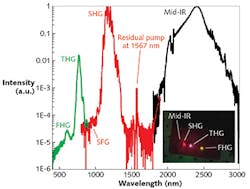Mid-IR Lasers: Kerr-lens mode-locking in polycrystalline Cr:ZnS and Cr:ZnSe competes with Ti:sapphire

The first solid-state mid-infrared (mid-IR) lasers introduced in the 1970s were based on alkali halide crystals containing color centers or oxide and fluoride crystals doped with trivalent rare earth ions. Those laser sources required cryogenic cooling of the gain media to prevent deactivation of accumulated population inversion via nonradiative phonon-assisted decay. Transition-metal-doped II-VI (TM:II-VI) semiconductors, introduced in the late 1990s by William Krupke's group at Lawrence Livermore National Laboratory (Livermore, CA), represent a viable route to practical room-temperature mid-IR lasing.
Chromium (Cr)-doped zinc sulfide (ZnS) and zinc selenide (ZnSe) are typical representatives of the TM:II-VI family and are often referred to as the "Ti:sapphire of the mid-IR" due to their four-level energy structure, absence of excited-state absorption, broad vibronic emission band enabling wide (1.8 to 3.4 μm) tunability, and high (close to 100%) quantum efficiency of fluorescence at room temperature (RT).
Compared to Ti:sapphire, Cr:ZnS/ZnSe features high emission cross-section (on the order of 10–18 cm2) as well as high second- and third-order nonlinearity. Conveniently, Cr:ZnS/ZnSe lasers can be pumped by affordable and reliable erbium (Er) and thulium (Tm) fiber lasers. This favorable blend of parameters has resulted in a variety of impressive laser results such as multiwatt output powers (18 W in gain switch and 30 W in pure continuous-wave (CW), high lasing efficiency (exceeding 60%), broad tunability in excess of 1000 nm, joule-level long-pulse output energy, and narrow spectral linewidth (less than 100 kHz).
Persistent efforts by several research teams have produced rapid progress in mode-locked Cr:ZnS/ZnSe lasers, as illustrated in Fig. 1. Active mode locking with picosecond pulse duration was realized in 2000, semiconductor saturable-absorber mirror (SESAM) mode-locking was demonstrated in 2005, and Kerr-lens mode-locking was achieved in 2009. Many important results on mode-locked Cr:ZnS/ZnSe lasers were first obtained using single-crystal samples, which are not readily available due to the difficult growth process.
Polycrystalline Cr:ZnS/ZnSe
An important advantage of polycrystalline Cr:ZnS/ZnSe laser media is the post-growth diffusion doping technology, which enables mass production of large-size laser gain elements with high dopant concentration, uniform dopant distribution, and low losses. As a result, polycrystalline materials gradually superseded single crystals in CW, gain-switched, and SESAM-mode-locked lasing regimes. Recent demonstrations of Kerr-lens mode-locking in polycrystalline Cr:ZnS/ZnSe have resulted in significant improvements of the laser parameters and have opened an avenue for real-world practical applications of ultrafast mid-IR lasers (see Fig. 1).
Optical resonators of ultrafast mid-IR Cr:ZnS/ZnSe lasers are similar to those in well-known Ti:sapphire oscillators. Management of the resonator's dispersion is an important design consideration, as it defines the parameters of the output laser pulses. Most designs of ultrafast Cr:ZnS/ZnSe lasers rely on Brewster mounting of the gain element (the de-facto standard in Ti:sapphire laser technology). Recent experiments revealed advantages of unconventional normal-incidence mounting of the gain element. Normal incidence mounting of polycrystalline Cr:ZnS/ZnSe resulted in mid-IR oscillators with the highest output power and the shortest pulse duration obtained to date (see arrows in Fig. 1).
The high optical nonlinearity of Cr:ZnS/ZnSe offers a number of interesting opportunities for nonlinear frequency conversion of femtosecond optical pulses. Polycrystalline Cr:ZnS/ZnSe consists of a multitude of microscopic single-crystal grains. Post-growth doping technology allows for manipulation of the microstructure and gives the ability to match the average size of the grain to, for example, the coherence length for second-harmonic generation (SHG).
The broad distribution of grain sizes and orientations results in so-called random quasi-phase-matching, which features a linear dependence of the conversion yield with thickness, as well as an ultra-wide bandwidth. The optical resonator can be optimized for maximum SHG conversion directly in the gain element of the ultrafast polycrystalline laser. Up to 0.25 W of SHG power at 1.2 μm has been obtained to date, and 0.5 W seems feasible in the near future.Numerous three-wave-mixing effects
The ultra-wide nonlinear bandwidth of polycrystalline Cr:ZnS/ZnSe leads to a plethora of three-wave-mixing effects, such as third- and fourth-harmonic generation and sum-frequency mixing between mid-IR femtosecond pulses and a CW pump beam, as illustrated in Figs. 2 and 3. There is little doubt that the effects of terahertz generation (via optical rectification of femtosecond laser pulses) and difference-frequency mixing (between femtosecond pulses and pump-laser emission) will be revealed soon by proper detection.
Furthermore, the synchronous pumping of polycrystalline Cr:ZnS/ZnSe by readily available 1.5 μm pico- and femtosecond Er fiber lasers may radically increase the yield of sum- and difference-frequency mixing by several orders of magnitude, and realize ultrafast oscillators with exceptionally broad spectral coverage spanning 1 to 4 μm. Further study of ultrafast lasers with random quasi-phase-matched gain media is an exciting research topic, which will likely lead to important practical results.The last decade of ultrafast mid-IR Cr:ZnS/ZnSe laser development was saturated by events and discoveries. Femtosecond lasers based on SESAM mode-lockers were gradually superseded by more robust Kerr-lens mode-locked oscillators. The recent advent of polycrystalline Kerr-lens mode-locked lasers with multiwatt output power and pulse durations approaching three optical cycles has brought the ultrafast mid-IR laser technology in line with that of state-of-the art Ti:sapphire oscillators. It was demonstrated that TM:II-VI materials offer unique possibilities for ultrafast lasing, and that a very broad range of parameters (output power, pulse duration, pulse repetition rate) can be realized using the same gain material.
The rapid progress of the past few years promises even more exciting achievements in a near future. Current research efforts include power scaling of ultrafast Cr:ZnS/ZnSe lasers to and beyond the 5 W level, development of octave-spanning mid-IR oscillators, and extension of ultrafast laser oscillations to the 4–8 μm spectral range.
REFERENCES
1. S. B. Mirov et al., IEEE J. Sel. Topics Quantum Electron., 21, 1601719 (2015).
2. I. T. Sorokina and E. Sorokin, IEEE J. Sel. Topics Quantum Electron., 21, 1601519 (2015).
3. S. Vasilyev, M. Mirov, and V. Gapontsev, "High power Kerr-lens mode-locked femtosecond mid-IR laser with efficient second harmonic generation in polycrystalline Cr2+:ZnS and Cr2+:ZnSe," Advanced Solid-State Lasers (ASSL) Conference, OSA Technical Digest, paper Am3A.3 (2014).
Sergey Vasilyev | Laser Scientist, IPG Photonics Southeast Technology Center
Sergey Vasilyev is an expert in laser design, light-matter interactions, and applications of laser-based sources for spectroscopy. He co-authored more than 100 papers on these topics and has both industrial and academic experience. After graduating from Moscow State University, Dr. Vasilyev earned his Ph.D. through the Russian Academy of Sciences. Since 2011, he has been a Laser Scientist with IPG Photonics Southeast Technology Center. He and his colleagues at IPG Photonics Southeast Technology Center hold a number of world records in the field of ultrafast mid-infrared lasers and frequency combs.
Mike Mirov | General Manager, IPG Photonics Southeast Technology Center
Mike Mirov received a Bachelor of Science in Electrical Engineering and Master of Science in Engineering both from the University of Alabama at Birmingham in 2006 and 2014. He was an engineer at the Center for Biophysical Sciences and Engineering at the University of Alabama at Birmingham from 2006 to 2010. Since then, he has been with IPG Photonics Southeast Technology Center (Birmingham, AL), where he is currently the General Manager. His research interests include laser materials, laser system engineering, and mid-infrared laser applications.
Valentin Gapontsev | Founder and CEO, IPG Photonics
Valentin Gapontsev (1939-2021) was founder and chief executive officer of IPG Photonics (Oxford, MA).

